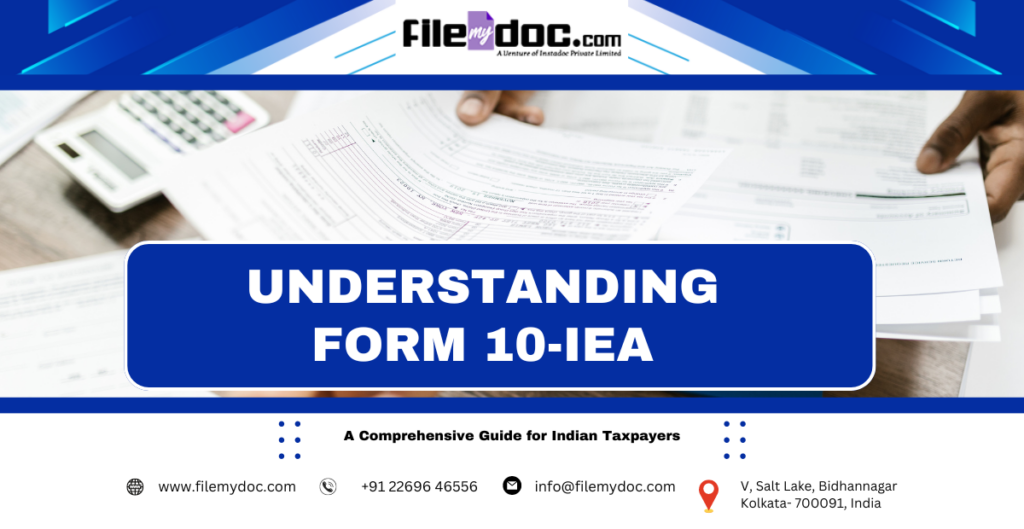Understanding Form 10-IEA: A Comprehensive Guide for Indian Taxpayers
Form 10-IEA is an essential document for taxpayers in India who wish to opt for the new tax regime under Section 115BAC of the Income Tax Act. This guide aims to provide a detailed overview of Form 10-IEA, including its purpose, eligibility criteria, filing process, and the impact it has on your tax liability.




What is Form 10-IEA?
Form 10-IEA is a declaration form introduced by the Indian government to enable taxpayers to opt for the new tax regime. Under Section 115BAC, this regime offers reduced tax rates in exchange for foregoing certain deductions and exemptions. The form must be submitted by individuals and Hindu Undivided Families (HUFs) who wish to switch to the new tax regime.
Who Should File Form 10-IEA?
Form 10-IEA is applicable to both salaried and non-salaried individuals, as well as HUFs, who are eligible to opt for the new tax regime under Section 115BAC. However, this form is not mandatory for all taxpayers. It is primarily for those who prefer the lower tax rates of the new regime over the deductions and exemptions available under the old tax regime.
Benefits of Filing Form 10-IEA
Filing Form 10-IEA offers several advantages:
- Lower Tax Rates: The new tax regime provides reduced tax rates compared to the old regime, which can result in significant tax savings for eligible taxpayers.
- Simplified Taxation: By opting for the new regime, taxpayers can avoid the complexities of claiming multiple deductions and exemptions, simplifying the tax filing process.
- Flexibility: Taxpayers have the option to choose between the old and new regimes each financial year, offering flexibility based on their financial situation.
Step-by-Step Guide to Filing Form 10-IEA
Filing Form 10-IEA is a straightforward process. Here’s how you can do it:
- Login to the Income Tax Portal: Start by logging into your account on the Income Tax Department’s official portal.
- Navigate to the Form 10-IEA Section: Once logged in, go to the e-File section and select the option to file Form 10-IEA.
- Fill in the Required Details: Enter the necessary details such as your name, PAN, assessment year, and select the option to opt for the new tax regime.
- Verify and Submit: After filling in the details, review the form carefully. Once you are satisfied, submit the form electronically.
- Acknowledgment Receipt: After submission, an acknowledgment receipt will be generated. Save this for your records.
Key Considerations When Opting for the New Tax Regime
Before deciding to file Form 10-IEA, it’s important to consider the following factors:
- Loss of Deductions: By opting for the new regime, you forgo deductions such as Section 80C, 80D, and others that can reduce your taxable income.
- Impact on Tax Liability: Analyze your total income and deductions under the old regime to see if the new regime offers a better tax outcome.
- Financial Planning: The choice between the old and new tax regimes should align with your long-term financial planning and investment strategy.
When to File Form 10-IEA?
The timing of filing Form 10-IEA is crucial. For salaried individuals, it should be filed before the employer processes the first salary of the financial year to ensure that TDS is deducted as per the new tax regime. Non-salaried individuals should file the form before the due date of filing their income tax return.
Consequences of Not Filing Form 10-IEA
If you do not file Form 10-IEA, you will automatically be assessed under the old tax regime, which may result in a higher tax liability if you are eligible for the new regime. It is, therefore, crucial to file this form if you wish to benefit from the lower tax rates.
Conclusion
Form 10-IEA is a valuable tool for Indian taxpayers who wish to take advantage of the new tax regime under Section 115BAC. By understanding the filing process and the benefits and drawbacks of the new regime, you can make an informed decision that aligns with your financial goals. Make sure to file Form 10-IEA within the stipulated time frame to ensure you benefit from the reduced tax rates and simplified taxation process.


























